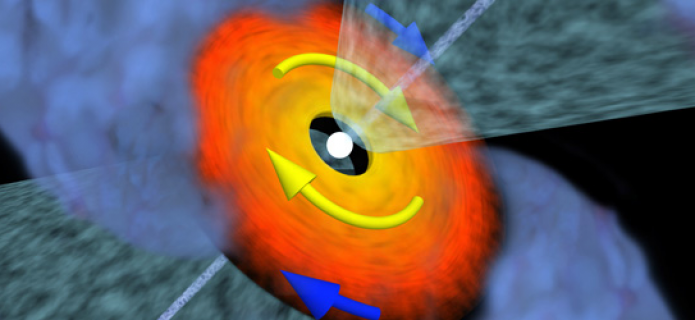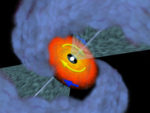Youngest protoplanetary disk discovered with ALMA
Planets form in disks around their host protostar, but when and how disks form is still an unanswered question. ALMA observations by a team of astronomers led by Nadia Murillo and Shih-Ping Lai [1] have found the youngest disk around a protostar to date, at an earlier stage than predicted by most models.
Material in our own Solar System follows Kepler's Laws, with the inner planets orbiting the Sun faster than planets further out. This is what is usually referred to as Keplerian rotation. Keplerian disks, that is disks with Keplerian rotation, are very likely to eventually form planets in stable orbits. Discovering these types of disks in the very early stage when the protostar is still deeply embedded in its natal cloud provides insight into the ability of these systems to form planets.
ALMA was used to observe VLA1623, a triple protostellar system located in the rho Ophiuchus star-forming cloud [2]. A disk structure was observed towards VLA1623A, a very young source still wrapped in its cocoon of dust and gas. Thanks to ALMA's capabilities, analysis of the gas in the disk revealed its motion to be Keplerian and to have a radius of roughly 5 times the radius of Neptune's orbit [3], but with a central protostar mass of only 0.2 times our Sun's mass. This shows that the protostar is still very young and growing.

Models and simulations have previously predicted that Keplerian disks cannot form in the earliest phases of star formation. However, the discovery of VLA1623A's big Keplerian disk proves otherwise, suggesting that other factors may play a role in disk formation. This is in line with more recent studies that suggest that misalignment of magnetic field and rotation axes or turbulence may enhance early disk formation, producing disks of 100 times the Earth-Sun radius or larger. The recent evidence that nearly all stars, including multiple stars, have at least one planet is in line with our observed result that nature finds a way to make protoplanetary disks.
Notes
[1] ALMA Cycle 0 data were obtained by Nadia Murillo and Shih-Ping Lai through East Asia partnership while Nadia Murillo was a Master student at National Tsing Hua University, Taiwan.
[2] Link to Ophiuchus WISE image in ALMA press release Jorgensen et al.
[3] The radius of Neptune's orbit around the Sun is about 30 times that of the Earth.
More information
The Atacama Large Millimeter/submillimeter Array (ALMA), an international astronomy facility, is a partnership of the European Organisation for Astronomical Research in the Southern Hemisphere (ESO), the U.S. National Science Foundation (NSF) and the National Institutes of Natural Sciences (NINS) of Japan in cooperation with the Republic of Chile. ALMA is funded by ESO on behalf of its Member States, by NSF in cooperation with the National Research Council of Canada (NRC) and the Ministry of Science and Technology (MOST) in Taiwan and by NINS in cooperation with the Academia Sinica (AS) in Taiwan and the Korea Astronomy and Space Science Institute (KASI).
ALMA construction and operations are led by ESO on behalf of its Member States; by the National Radio Astronomy Observatory (NRAO), managed by Associated Universities, Inc. (AUI), on behalf of North America; and by the National Astronomical Observatory of Japan (NAOJ) on behalf of East Asia. The Joint ALMA Observatory (JAO) provides the unified leadership and management of the construction, commissioning and operation of ALMA.
The research findings are presented in the article "A Keplerian disk around a Class 0 source: ALMA observations of VLA1623A" published in the Astronomy and Astrophysics Journal, Vol. 560, of December 13, 2013. The paper is here
The research team members are: N. Murillo (Max-Planck-Institute for extraterrestrial Physics, Garching, Germany [MPE]), S.-P. Lai (Institute of Astronomy, National Tsing Hua University, Hsinchu, Taiwan), S. Bruderer (MPE), D. Harsono (Leiden Observatory, Leiden University, the Netherlands) and E. F. van Dishoeck (Leiden Observatory; MPE).
Contact:
Valeria Foncea
Education and Public Outreach Officer
Joint ALMA Observatory
Santiago, Chile
Tel: +56 2 467 6258
Cell: +56 9 75871963
Email: [email protected]
Masaaki Hiramatsu
Education and Public Outreach Officer, NAOJ Chile
Observatory
Tokyo, Japan
Tel: +81 422 34 3630
E-mail: [email protected]
Charles E. Blue
Public Information Officer
National Radio Astronomy Observatory
Charlottesville, Virginia, USA
Tel: +1 434 296 0314
Cell: +1 434.242.9559
E-mail: [email protected]
Richard Hook
Public Information Officer, ESO
Garching bei München, Germany
Tel: +49 89 3200 6655
Cell: +49 151 1537 3591
Email: [email protected]

